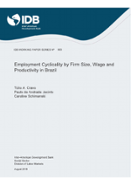Employment Cyclicality by Firm Size, Wage and Productivity in Brazil
Date
Aug 2018
The important debate about how economic fluctuations affect employment reallocation in heterogeneous businesses is currently open in the literature. This debate is relevant as it matters for the understanding of the labor market dynamics, and for devising labor policies that aim at dampening employment fluctuations. The theoretical literature suggests that job-to-job flows reallocate workers from low productivity to high productivity firms and often this pattern is tested assuming that firm size, wages and productivity are positively related. This paper constructs a unique monthly linked employer-employee data based on the Annual Manufacturing Survey (PIA) and contributes to this debate by providing direct empirical evidence on the cyclicality of employment in heterogeneous firms in a developing country. Results produced by classifying firms by employment size, wage or productivity show different responses of employment growth rates to business cycles. The relationship between these variables is not as strong as suggested in some influential studies and thus a direct productivity measures should be used. When Total Factor Productivity is used to rank firms, results suggest that employment in high productivity firms are more cyclically sensitive to unemployment. Besides, the VAR impulse response analysis suggests that workers move up the productivity ladder by moving from new firms with low productivity to old firms with high productivity.




